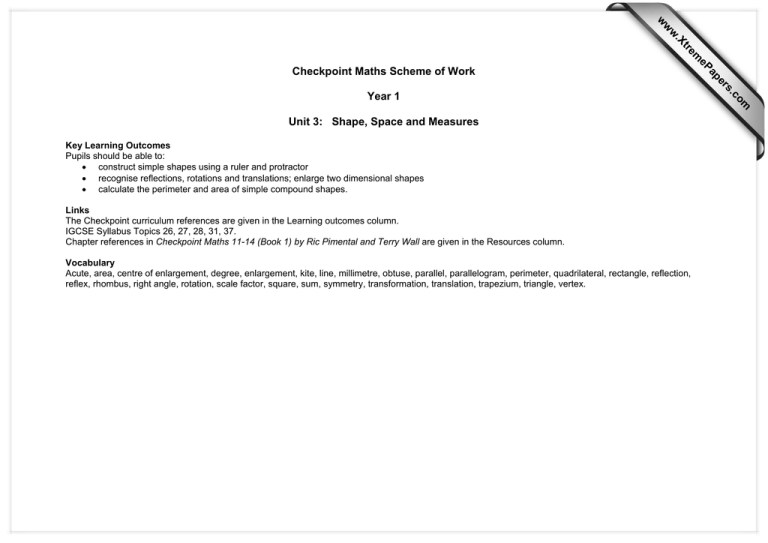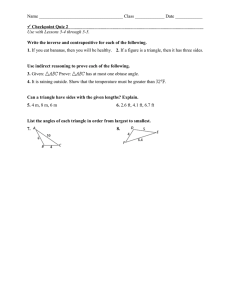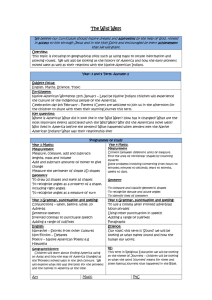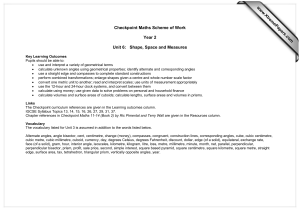Checkpoint Maths Scheme of Work Year 1
advertisement

Key Learning Outcomes Pupils should be able to: • construct simple shapes using a ruler and protractor • recognise reflections, rotations and translations; enlarge two dimensional shapes • calculate the perimeter and area of simple compound shapes. Links The Checkpoint curriculum references are given in the Learning outcomes column. IGCSE Syllabus Topics 26, 27, 28, 31, 37. Chapter references in Checkpoint Maths 11-14 (Book 1) by Ric Pimental and Terry Wall are given in the Resources column. Vocabulary Acute, area, centre of enlargement, degree, enlargement, kite, line, millimetre, obtuse, parallel, parallelogram, perimeter, quadrilateral, rectangle, reflection, reflex, rhombus, right angle, rotation, scale factor, square, sum, symmetry, transformation, translation, trapezium, triangle, vertex. om .c Unit 3: Shape, Space and Measures s er ap Year 1 eP m e tr .X w w w Checkpoint Maths Scheme of Work Learning Outcomes Sg3 Use a ruler and protractor to: ♦ measure and draw lines to the nearest millimetre and angles to the nearest degree ♦ construct a triangle given two sides and the included angle or two angles and the included side. Suggested Teaching Activities Discuss acute, obtuse and reflex angles and the need to check which scale on the protractor to use. Resources Measuring angles at www.mymaths.co.uk Discuss experimental error and accuracy and emphasise the need for accuracy (for example, use a sharp pencil). Checkpoint Maths 11-14 (Book 1) Chapter 3 Try to draw ‘impossible’ triangles (e.g. a triangle where two of its angles are 100° and 90°) and then describe why they will not work. Devise a rule for obtuse angles in triangles. Sg4 Understand and use the language and notation associated with reflections, translations and rotations. Recognise the transformations: reflection in a given line, translation, rotation about a given point. Give plenty of practical work – use coloured pens/pencils and tracing paper. www.mathsnet.net/transform/index.html Checkpoint Maths 11-14 (Book 1) Chapter 13 Encourage the students to find out, for each transformation, how much information has to be given to specify the transformation exactly. Checkpoint Maths 11-14 (Book 1) Chapter 18 Understand and use the language and notation associated with enlargement. Enlarge 2-D shapes, given a centre of enlargement and a positive whole number scale factor. Sm5 Know and use the formula for the area of a rectangle. Deduce and use the formula for the area of a triangle, parallelogram and trapezium. Calculate perimeters and areas of compound shapes made from rectangles and triangles. Use a series of graduated exercises. Ask for both the perimeter and the area where possible. Start with shapes on squared paper and progress to plain paper. www.mathgoodies.com/lessons/toc_vol1.html Find different ways of partitioning compound shapes to calculate total area, including some by subtraction. Checkpoint Maths 11-14 (Book 1) Chapter 25 Draw plans of the classroom and corridors and work out the area of floor covering required. Checkpoint Maths 11-14 (Book 1) Chapter 23


